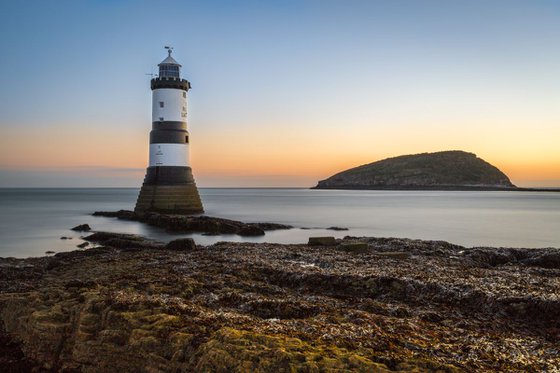- By medium
- By subject
- By budget
- Sales
- Gift cards
- Discover all art
- Artists
- Editors’ picks
- Ideas
Artwork description:
Trwyn Du Lighthouse, Penmon, Anglesey, North Wales.
There had been a call for a light at this location for some years by master shipmen in the nearby city of Liverpool especially after the steamer the Rothsay Castle ran aground and broke up nearby in 1831 with 130 people losing their lives. The first lighthouse was erected in 1838, at a price of £11,589.
The present Lighthouse is 29m tall and was designed by James Walker and built in 1835-1838. It was his first sea-washed tower, and a prototype for his more ambitious tower on the Smalls.
The Lighthouse has a stepped base designed to discourage the huge upsurge of waves that had afflicted earlier lighthouses on the site and reduce the force of the water at the bottom of the tower.
Austere vertical walls, instead of the usual graceful lines of other rock towers, are probably an economy measure. The tower has a crenellated stone parapet, in preference to iron railings on the gallery, and narrows in diameter above the halfway point. These are a features used by Walker in his other lighthouse designs. The tower is distinguished by its original three black bands painted on a white background.
Walker also pioneered, unsuccessfully, the use of a primitive water closet, comprising a specially designed drain exiting at the base of the tower. The stepped design of the lighthouse may have helped water exit the closet, but surges of seawater made its use difficult during heavy weather.
Printed on Hahnemühle Photo Rag Baryta paper with a weight of 315gsm.
Rag Baryta is a fine art paper with a very fine surface texture and a glossy Baryta coating.
Materials used:
Giclée print - Hahnemühle Photo Rag Baryta 315gsm
Tags:
#wales history #landscape #seascape #sea #beach #beach scene #seaside #coastal #coast #landscapes #travel #lighthouse #landscape photography #coastline #beachscape #wales #landscape print #coastal art #ancient #monument #anglesey coastline #landscape photograph #anglesey #celtic #lighthouse and cliffs #wales coastline #lighthouses #wales beach #penmon #wales coastal path #penmon lighthouse #archaeologicalTrwyn Du Lighthouse (2016) Photograph
by Kevin Standage
1 Artist Reviews
£199
- Photograph on Paper
- From a limited edition of 100
- Size: 66 x 45.6 x 0.1cm (unframed) / 61 x 40.6cm (actual image size)
- Signed and numbered on the back
- Style: Photorealistic
- Subject: Landscapes, sea and sky
- Hurry only 1 left in stock
Loading
Artwork description
Trwyn Du Lighthouse, Penmon, Anglesey, North Wales.
There had been a call for a light at this location for some years by master shipmen in the nearby city of Liverpool especially after the steamer the Rothsay Castle ran aground and broke up nearby in 1831 with 130 people losing their lives. The first lighthouse was erected in 1838, at a price of £11,589.
The present Lighthouse is 29m tall and was designed by James Walker and built in 1835-1838. It was his first sea-washed tower, and a prototype for his more ambitious tower on the Smalls.
The Lighthouse has a stepped base designed to discourage the huge upsurge of waves that had afflicted earlier lighthouses on the site and reduce the force of the water at the bottom of the tower.
Austere vertical walls, instead of the usual graceful lines of other rock towers, are probably an economy measure. The tower has a crenellated stone parapet, in preference to iron railings on the gallery, and narrows in diameter above the halfway point. These are a features used by Walker in his other lighthouse designs. The tower is distinguished by its original three black bands painted on a white background.
Walker also pioneered, unsuccessfully, the use of a primitive water closet, comprising a specially designed drain exiting at the base of the tower. The stepped design of the lighthouse may have helped water exit the closet, but surges of seawater made its use difficult during heavy weather.
Printed on Hahnemühle Photo Rag Baryta paper with a weight of 315gsm.
Rag Baryta is a fine art paper with a very fine surface texture and a glossy Baryta coating.
Materials used:
Giclée print - Hahnemühle Photo Rag Baryta 315gsm
Tags:
#wales history #landscape #seascape #sea #beach #beach scene #seaside #coastal #coast #landscapes #travel #lighthouse #landscape photography #coastline #beachscape #wales #landscape print #coastal art #ancient #monument #anglesey coastline #landscape photograph #anglesey #celtic #lighthouse and cliffs #wales coastline #lighthouses #wales beach #penmon #wales coastal path #penmon lighthouse #archaeological14 day money back guaranteeLearn more

